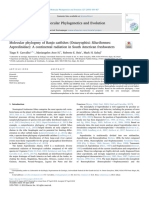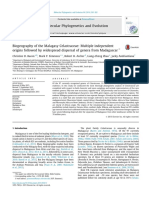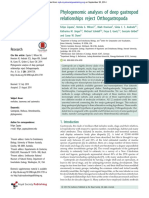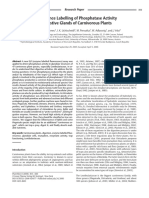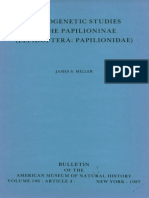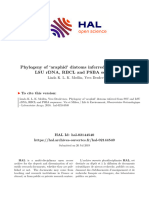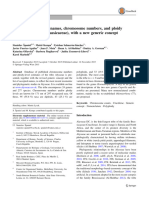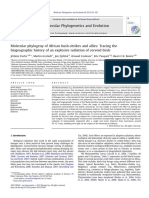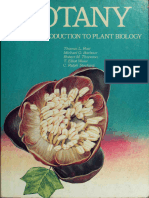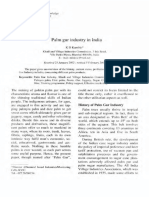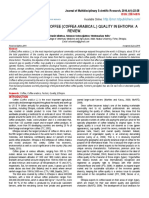A detailed investigation of the Pterocarpus clade (Leguminosae: Dalbergieae):
Etaballia
with radially symmetrical
owers is nested within thepapilionoid-
owered
Pterocarpus
Bente B. Klitgård
, Félix Forest
, Thomas J. Booth
, C. Haris Saslis-Lagoudakis
a
Herbarium, Library, Art and Archives, Royal Botanic Gardens, Kew, Richmond, TW93AE, United Kingdom
b
Jodrell Laboratory, Royal Botanic Gardens, Kew, Richmond, TW93DS, United Kingdom
c
Macroevolution and Macroecology Group, Research School of Biology, Australian National University, Canberra, 0200, Australia
a b s t r a c ta r t i c l e i n f o
Available online 28 August 2013Edited by JC Manning
Keywords:
Phylogeny
EtaballiaPterocarpus
Radially symmetric
owersITS2trnL-FndhF-rpL32matKrbcL
The pantropical genus
Pterocarpus
(Leguminosae: Dalbergieae) with papilionoid
owers, and allied gen-era in the Pterocarpus clade were sampled for the
ve molecular markers ITS2,
trnL-F
,
ndhF-rpL32
,
matK
,and
rbcL
, as part of our ongoing systematic studies in the clade. For wider analyses of the Pterocarpusclade the remaining 14 members of this clade were also sampled for
matK
. Phylogenetic analyses wereperformed under the maximum likelihood criterion (ML) and Bayesian criteria. In the
ve-marker anal-ysis of the core Pterocarpus clade (including 106 accessions) two robustly supported clades were re-solved. The
rst clade includes
Centrolobium
,
Etaballia
,
Inocarpus
,
Maraniona
,
Paramachaerium
,
Pterocarpus
,
Ramorinoa
, and
Tipuana
. The second includes all species of
Pterocarpus
(except
P.acapulcensis
),
Etaballia
with radially symmetric
owers, and
Paramachaerium
.
Paramachaerium
is placedas sister to the several
Pterocarpus
species from South America, while
Etaballia
is resolved within theclade containing the African and Asian species of
Pterocarpus
. The wider sampled
matK
data set includes199 accessions.
Discolobium
and
Riedeliella
are recovered as sister to the remaining Pterocarpus clade.
Platymiscium
is strongly supported as sister to the rest of the members of the clade, and
Pterocarpusacapulcensis
is also here resolved in a separate lineage from the remaining
Pterocarpus
accessions. Weused the phylogenies to investigate patterns of
oral evolvability in the Pterocarpus clade, which includefour genera with actinomorphic
owers (
Acosmium s.s.
,
Etaballia
,
Inocarpus
and
Riedelliela
). Our results re-inforce the hypothesis that
ower evolvability is high in early-branching legume lineages, and that actino-morphy has evolved independently four times in the Pterocarpus clade. In light of our results, thetaxonomic status of the monospeci
c genus
Etaballia dubia
Benth. was revisited, and the species is synon-ymized as belonging to
Pterocarpus
, under the name
Pterocarpus dubius
Spreng., published in 1827, buthiding in synonymy for nearly two centuries.Crown Copyright © 2013 Published by Elsevier B.V. on behalf of SAAB. All rights reserved.
1. Introduction
The decrease in costs and increase in methodological ef
ciencyin molecular techniques in the past decade have resulted in an ex-plosion in molecular phylogenetic research in general, includingstudies focused on the legume family. Among
owering plant fam-ilies, Leguminosae encompasses one of the widest ranges in geo-graphic distribution, habitat preference, habit type, leaf,
owerand fruit morphology, thus the family serves as an excellentmodel for evolutionary studies [e.g. Dalbergioids (Lavin et al.,2001),
Aeschynomene
Acosmium
Lonchocarpus
Steinbachiella
(Lewis et al., 2012)]. Phylogenetic studies within the Leguminosaehave not only contributed to a much better understanding of rela-tionships among legume genera, but they have also sometimeshighlighted cases where a recircumscription of the generic and/ortribal concepts was necessary [e.g. Dalbergioids (Lavin et al.,2001),
Aeschynomene
Acosmium
Lonchocarpus
Steinbachiella
(Lewis et al., 2012)]. Similarly, these studies have often required arethink of widely accepted views about habitat preference and mor-phological evolvability (e.g. Cardoso et al., 2012a,b,c; Lavin et al.,2001; McMahon and Hufford, 2004; Pennington et al., 2000;
⁎
Corresponding author. Tel.: + 44(0)2083325257.
E-mail address:
–
see front matter. Crown Copyright © 2013 Published by Elsevier B.V. on behalf of SAAB. All rights reserved.http://dx.doi.org/10.1016/j.sajb.2013.07.006
Contents lists available at ScienceDirect
South African Journal of Botany
journal homepage: www.elsevier.com/locate/sajb

rst drew attention to 23 papilionoid genera with radially sym-metric
owers, representing nine reversals from zygomorphy to ac-tinomorphy in their phylogenetic analyses of early-divergingpapilionoids. This number increased to twelve with the additionalthree discovered subsequently by Lavin et al. (2001) within the rel-atively early-branching Dalbergioid clade. These taxa were thoughtto be
“
primitive
”
by authors of earlier legume classi
cations (e.g.Polhill, 1981, 1994; Yakovlev, 1975), but showed to be scatteredamong early-branching papilionoid lineages including mainly gen-era with
“
less primitive
”
papilionoid
owers (Lavin et al., 2001;Pennington et al., 2000, 2001). Those authors also noted that de-spite apparent multiple origins of actinomorphic
owers in theselineages, the non-papilionoid
ower morphologies do not occur inmore derived lineages of the Papilionoideae. Explaining this phylo-genetic pattern in the distribution of actinomorphic
owers have become more canalized (e.g. a zygomor-phic corolla with fusion of petals and stamens, often seen in themore derived legume taxa such as
Medicago
spp.,
Pisum
spp., and
Swainsona
spp.), it is more dif
cult to revert to a non-papilionoid
ower morphology. Furthermore, zygomorphy might be conservedin late-branching lineages, as it has been a key innovation associat-ed with high diversi
cation rates in various lineages (e.g. Arroyo,1981; Citerne et al., 2010; Endress, 1999, 2001; Sargent, 2004). Re-cently, this evolutionary pattern of repeated reversal from zygo- toactinomorphy has proven even more widespread among theearly-branching papilionoids (Boatwright et al., 2008; Cardoso etal., 2012a, 2012b, 2013).Since Bronn ex De Candolle (1825) coined the tribe nameDalbergieae it has taken several shapes and guises until Lavin etal.'s (2001) groundbreaking paper united 44 genera, previouslythought to belong to
ve different tribes, in one monophyleticgroup. They called this expanded group the
“
Dalbergioid clade
”
,and subdivided it into three well-supported subclades: theAdesmia, Pterocarpus, and Dalbergia clades. This paper alsoformed the basis for the circumscription of the Dalbergieae(Klitgård and Lavin, 2005) in Legumes of the World (Lewis et al.,
2005). Since 2005, three new genera have been added to thegroup, increasing the number of genera assigned to the Dalbergieaeto a current total of 47 members.
Steinbachiella
Harms was reinstat-ed and placed in the Dalbergia clade (Lewis et al., 2012), while thePterocarpus clade acquired two new additions: the monospeci
c
Maraniona lavinii
C.E. Hughes, G.P. Lewis, Daza & Reynel., a new dis-covery from the interandean valleys of Peru (Hughes et al., 2004),and
Acosmium
Schott
s.s.
(three spp.) joining the Pterocarpusclade segregated from the other members of
Acosmium
which areplaced in the Bowdichia clade of the Genistioids under the new ge-neric names
Leptolobium
and
Guianodendron
(Cardoso et al.,2012a). In the Pterocarpus clade a number of genera have beenthe focus of recent species level phylogenetic studies:
Platymiscium
Centrolobium
Pterocarpus
Acosmium
(Cardoso et al., 2012a), which have improved the resolu-tion of the core Pterocarpus clade. Nevertheless, infrageneric rela-tionships within the wider Pterocarpus clade are still notwell-resolved.
Etaballia
Benth. is a monospeci
c legume tree genus, restrictedto periodically inundated humid tropical rainforests of Brazil, theGuianas, and Venezuela, and has recently also been recorded fromPando in the Bolivian Amazon (voucher
Klitgård et al. 1394
owers and samaroid fruits,
Etaballia
has had a turbulent taxonomic history, since Bentham (1840a)
rst published
Etaballia guianensis
Benth. [=
E. dubia
(Kunth)Rudd] as a member of the Bauhinieae,
“
allied to [the genus]
Schnella
…”
Etaballia
wasplaced in synonymy under
Inocarpus
Forst., a Southeast Asianmonospeci
c genus also with unifoliolate leaves and radially sym-metric
owers, but with drupaceous fruits, and placed as
“
genusanomalum
”
in tribe Dalbergieae. Subsequently, most authors havegiven
Etaballia
1907; Ducke, 1949; Funch andSantos, 1997; Klitgård and Lavin, 2005; Lavin et al., 2001; Polhill,1981), while some have placed it elsewhere in the legume family:intermediate between subfamilies Mimosoideae and Papilionoideae(Kuhlmann, 1949); in a
“
primitive position
”
—
in synonymy under
Inocarpus
; Polhill,1994; Yakovlev, 1975); and between subfamilies Caesalpinioideae andPapilionoideae (Barroso et al., 1984). Some authors have commentedon the resemblance of the fruits of
Etaballia dubia
to those of thetwo amphiatlantic species,
Pterocarpus of
cinalis
—
when publishing
Hecastaphyllum dubia
Kunth (=
E. dubia
P. santalinoides
DC. (Rojo, 1972), which share asamaroid (sometimes appearing drupaceous) fruit with a narrowwing encircling 1/3 to 2/3 of the circumference of the seed chamber(Fig. 2).Another member of the Pterocarpus clade which has had acomplex taxonomic history is
Paramachaerium
Ducke, currentlyconsisting of
ve species distributed in the Amazonian regions of the Guianas, Venezuela, Brazil, Peru, and Panama (Klitgård andLavin, 2005; Rudd, 1981). In 1925 Ducke segregated
Machaeriumschomburgkii
Pterocarpus kuhlmannii
Machaerium
,published the genus
Paramachaerium
and based it on the typespecies
Paramachaerium schomburgkii
Ducke [=
Pterocarpusormosioides
Fig. 1.
Pterocarpus dubius
Spreng. (=
Etaballia dubia
(Kunth) Rudd [as
Etaballia guianensis
Benth.]), plates
rst published in Hooker's Icones (1842).129
B.B. Klitgård et al. / South African Journal of Botany 89 (2013) 128
–
142
species have been added:
Paramachaerium gruberi
P. krukovii
Rudd and
P. schunkei
Paramachaerium
and
Pterocarpus
Paramachaerium
as closely related to
Pterocarpus
, its exact systematic position hasremained unclear.Here we present an updated phylogeny of the Pterocarpusclade with higher resolution for some critical nodes, and a taxo-nomic evaluation of the monospeci
c genus
Etaballia
. The pres-ent study investigates intrageneric relationships and patterns of
oral evolvability in the Pterocarpus clade of the tribeDalbergieae, which currently includes four genera with actino-morphic
owers (
Acosmium s.s.
,
Etaballia
,
Inocarpus
and
Riedelliela
).Our results further reinforce the hypothesis that
owerevolvability is high in early-branching legume lineages, and thatactinomorphyhasevolvedindependentlyfourtimesinthePterocarpusclade.
2. Material and methods
2.1. Taxon sampling
We included all
Pterocarpus
species as in our previous phyloge-netic study (Saslis-Lagoudakis et al., 2011), as well as eight moreaccessions of American
Pterocarpus
species belonging to the
P. rohrii
complex, currently under study by Mans
eld-Williams &Hawkins at Reading University, and Klitgård & Saslis-Lagoudakisat RBG, Kew. For
Etaballia
and
Paramachaerium
, we included theaccessions available from a previous study (Lavin et al., 2001)and extended the sampling by including three additional samplesfrom both genera. Outgroup selection was based on previous
Fig.2.
Pterocarpusdubius
Spreng.A.Floweringbranchof[
B.B.Klitgård1394
etal.(USZ)],photograph©B.Klitgård,RBG,Kew.B.Fruitsof
Pterocarpusdubius
[
L.William1308
(F)].C.Fruitsof
Pterocarpus of
cinalis
[
B.V. Rabelo et al. 2071
(K)]. D. Fruits of
Pterocarpus santalinoides
[
D. Zappi et al. 1100
(K)].
Discolobium Platymiscium Cascaronia Chapmannia Arachis Brya Acosmium Grazielodendron Platypodium Maraniona Pterocarpus acapulcensis Inocarpus Tipuana Ramorinoa Centrolobium Pterocarpus -
Fig. 3.
Synopsis of the phylogenetic tree recovered from the maximum likelihood (ML)analysis, using all DNA markers (nrITS2,
rbcL
,
matK
,
trnL
and
ndhF-rpL32
). Numbersabove branches show bootstrap percentages (BP). Branches with BP
b
50 werecollapsed.130
B.B. Klitgård et al. / South African Journal of Botany 89 (2013) 128
–
142
phylogenetic studies of the
Pterocarpus
clade (Hughes et al., 2004;Lavin et al., 2001; Pirie et al., 2009; Saslis-Lagoudakis et al., 2008,2011), ensuring that exemplar sequences from all major lineageswithin the clade were represented.
Acosmium
, recently identi
ve additional accessions for
Maraniona
and one for
Tipuana
.
Discolobium
was used as outgroup taxon,representing the
Discolobium
–
Riedeliella
matK
se-quences that are publicly available in GenBank for the
Pterocarpus
clade from previous studies, and added our newly generated
matK
sequences to that dataset in order to produce a phylogenetic treewith wider and denser sampling across the clade. Exemplar speciesfrom the
Dalbergia
and
Adesmia
clades were also included, and
Amicia
and
Adesmia
2.2. Molecular methods and phylogenetic analyses
Total DNA was extracted from 0.2 to 0.3 g of leaf and/or
owertissue from herbarium or silica gel dried material using a modi
ed using QIAquick PCR columns(Qiagen, Crawley, West Sussex, UK) following the manufacturer'sprotocol.Five DNA markers were ampli
ed, one nuclear (internal tran-scribed spacer 2, ITS2) and four plastid (
trnL
-
F
intergenic spacer,the barcoding fragment of
matK
, the
rst half of
rbcL
, and the
Clade A
P. santalinus P. michelianus P. ternatus P. erinaceus P. zehntnerii P. amphymenium P. violaceus Maraniona lavinii P. lucens antunesii P. indicus Etaballia dubia P. angolensis P. indicus P. rohrii P. mildbraedii mildbraedii P. santalinoides P. santalinoides P. reticulatus P. lucens lucens P. rohrii P. hayesii P. tessmannii P. rotundifolius polyanthus P. violaceus angustifolius Paramachaerium schomburgkii P. marsupium P. soyauxii P. tinctorius chrysothrix Maraniona lavinii P. floribundus P. rohrii P. brenanii Etaballia dubia P. dalbergioides P. cf. erinaceus P. rotundifolius rotundifolius P. lucens lucens Maraniona lavinii Pterocarpus acapulcensis P. officinalis officinalis P. amphymenium P. tinctorius P. tinctorius odoratus P. osun Tipuana tipu Ramorinoa P. rohrii P. tinctorius chrysothrix Centrolobium P. lucens lucens P. monophyllus P. santalinoides P. soyauxii P. officinalis gilletii Paramachaerium schomburgkii P. tinctorius albopubescens P. floribundus P. angolensis P. rotundifolius polyanthus martinii P. indicus P. amphymenium P. amazonum P. rohrii P. santalinus P. santalinoides P. brenanii P. macrocarpus P. rotundifolius polyanthus martinii P. santalinoides P. tinctorius P. marsupium Maraniona lavinii Maraniona lavinii P. amazonum Maraniona lavinii P. erinaceus Etaballia dubia P. magnicarpus P. amphymenium Tipuana tipu Inocarpus fagifer P. steinbachianus P. villosus Paramachaerium ormosoides Etaballia dubia P. mildbreadii usambarensis P. tinctorius holtzii P. hayesii P. reticulatus P. marsupium P. steinbachianus P. santalinus Pterocarpus acapulcensis P. officinalis officinalis Paramachaerium schomburgkii P. reticulatus
10067925780666990995410090551009892947998671009498100826210079945310072831009185985610010010056529294100100609390701008665100631009110010090789910010098605461
Clade B
531.000.971.001.001.001.001.001.001.001.001.001.001.001.000.981.000.960.951.001.001.000.991.001.001.001.001.001.001.001.001.000.990.941.001.001.000.980.931.000.990.911.001.001.001.001.001.001.001.001.001.001.00
Neotropical
Pterocarpus
African
Pterocarpus
Asian
Pterocarpus Paramachaerium Etaballia Pterocarpus acapulcensis
Fig. 4.
Phylogenetic tree recovered from the maximum likelihood (ML) analysis, using all DNA markers (nrITS2,
rbcL
,
matK
,
trnL
and
ndhF-rpL32
). Numbers above branches showbootstrap percentages (BP) and those below branches show posterior probabilities (PP) from a Bayesian analysis of the same dataset. Only values above 50 (BP) and 0.90 (PP) areshown. Branches with both BP
b
50 and PP
b
0.90 were collapsed.131
B.B. Klitgård et al. / South African Journal of Botany 89 (2013) 128
–
142













